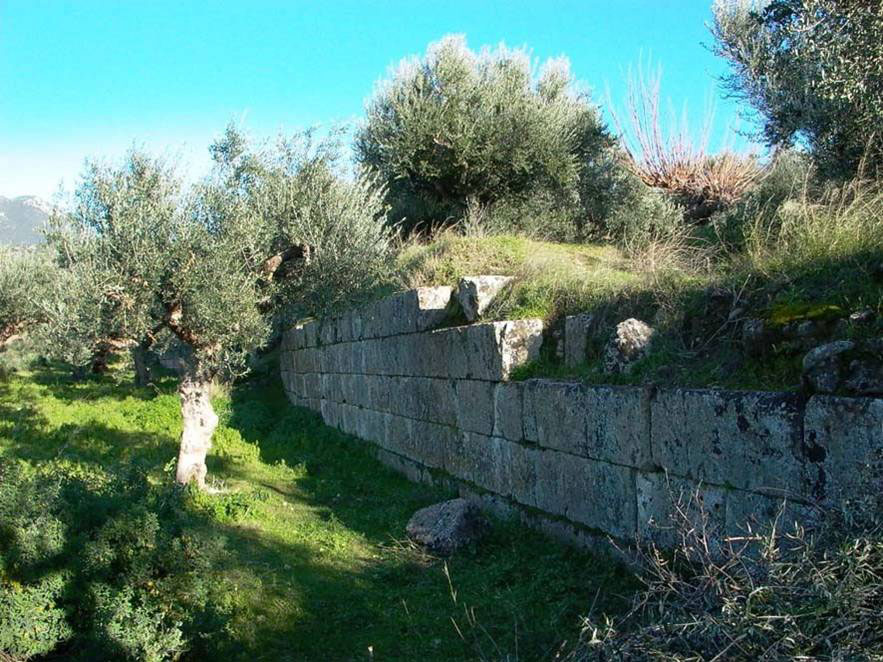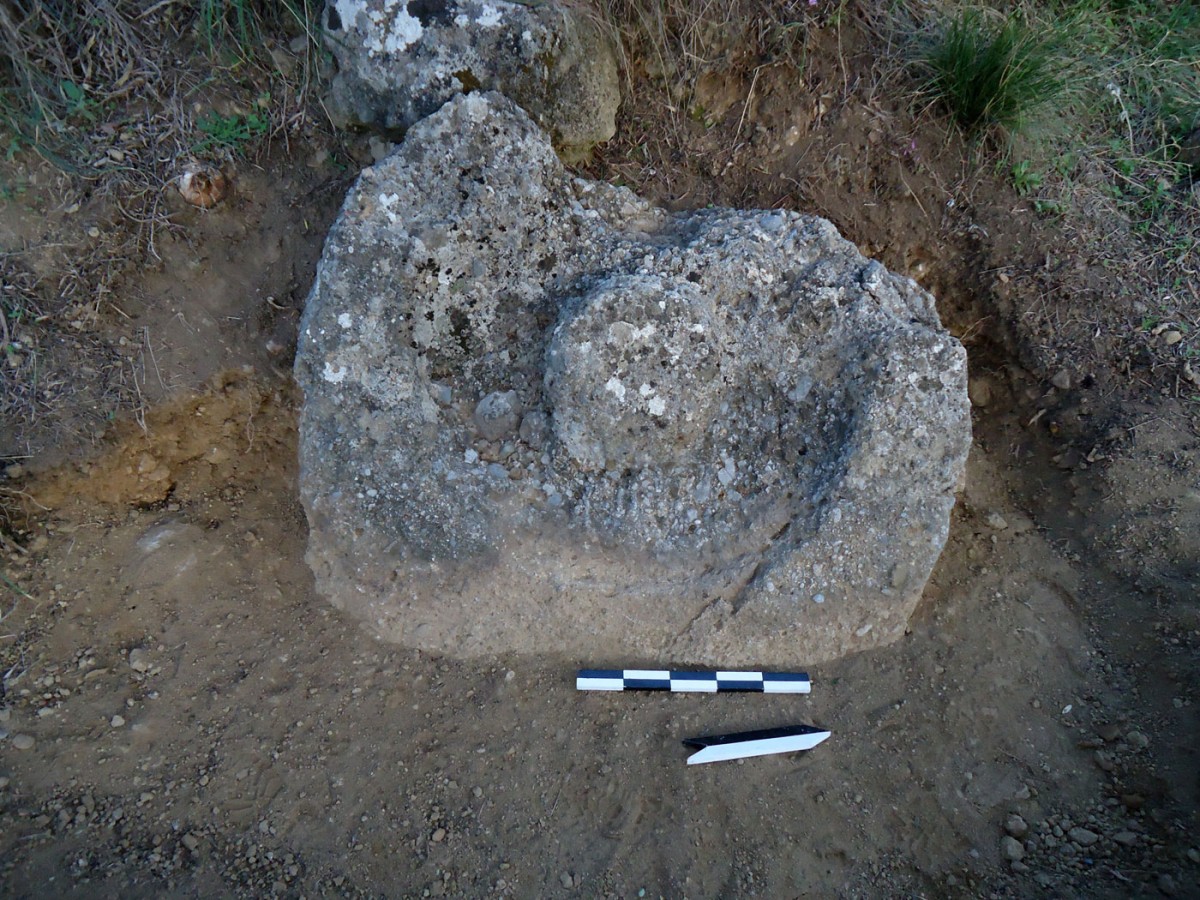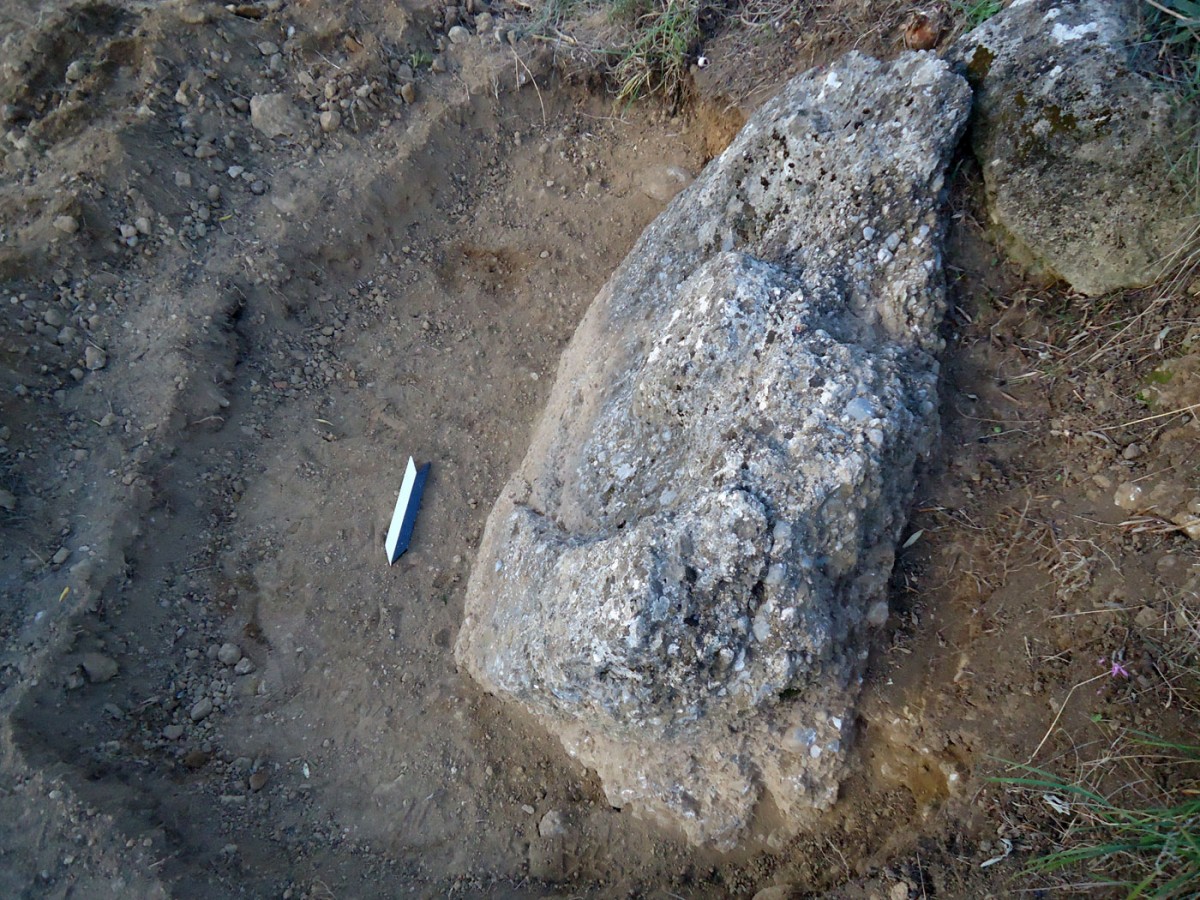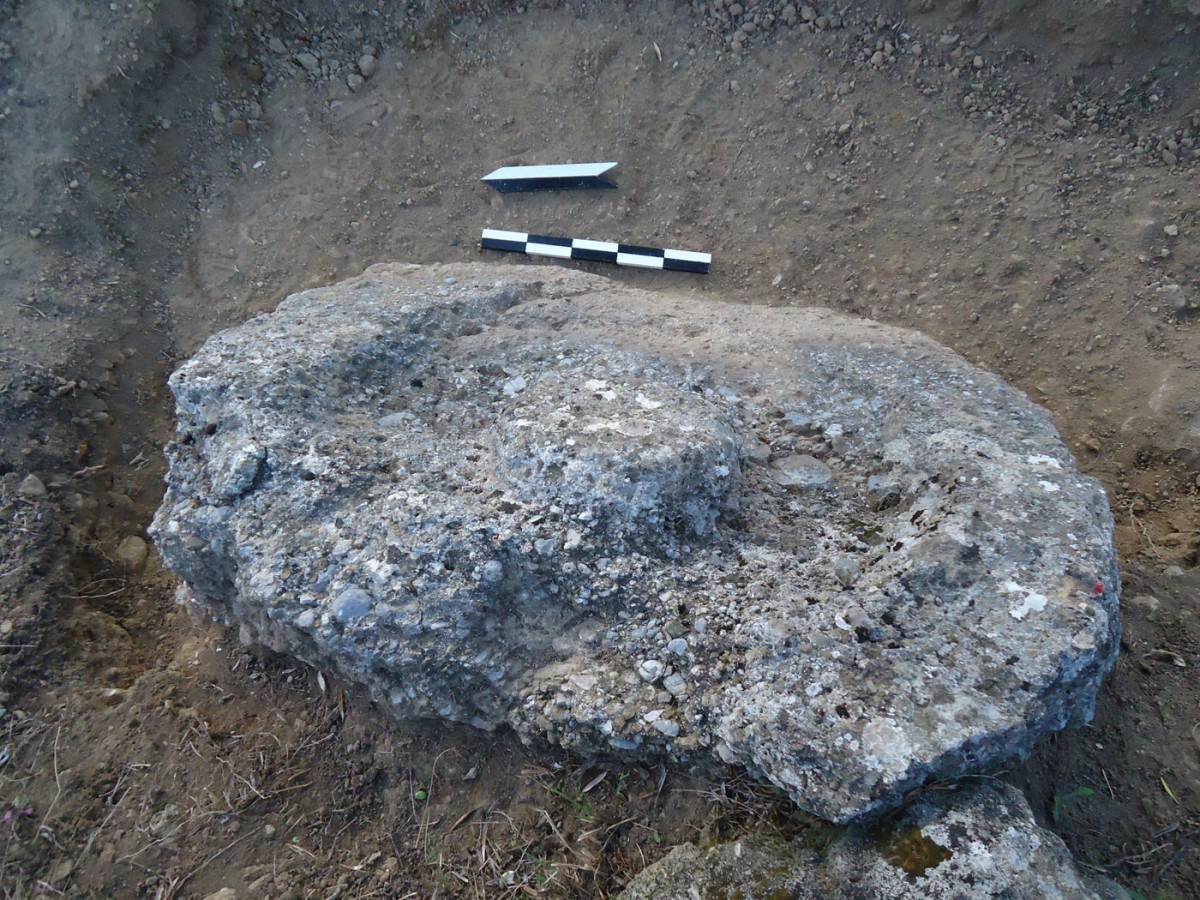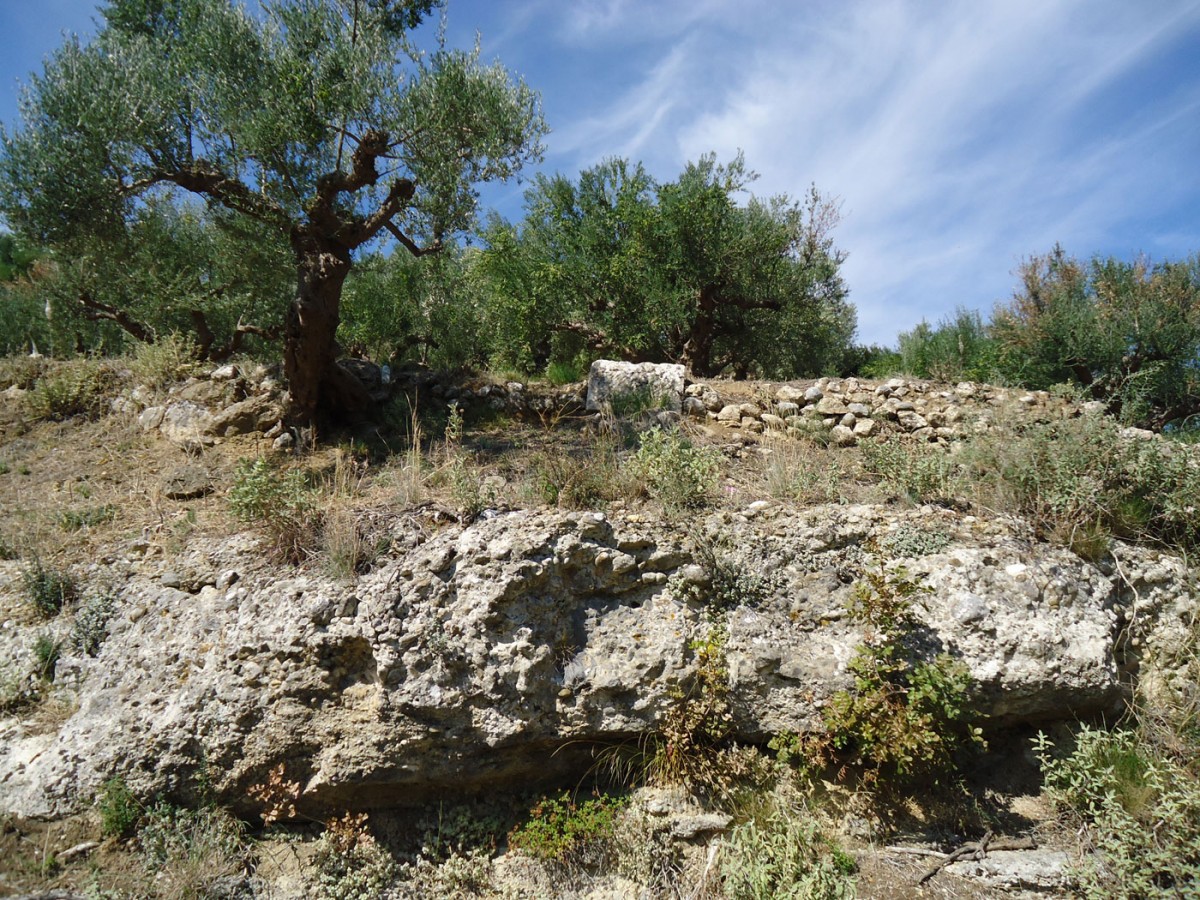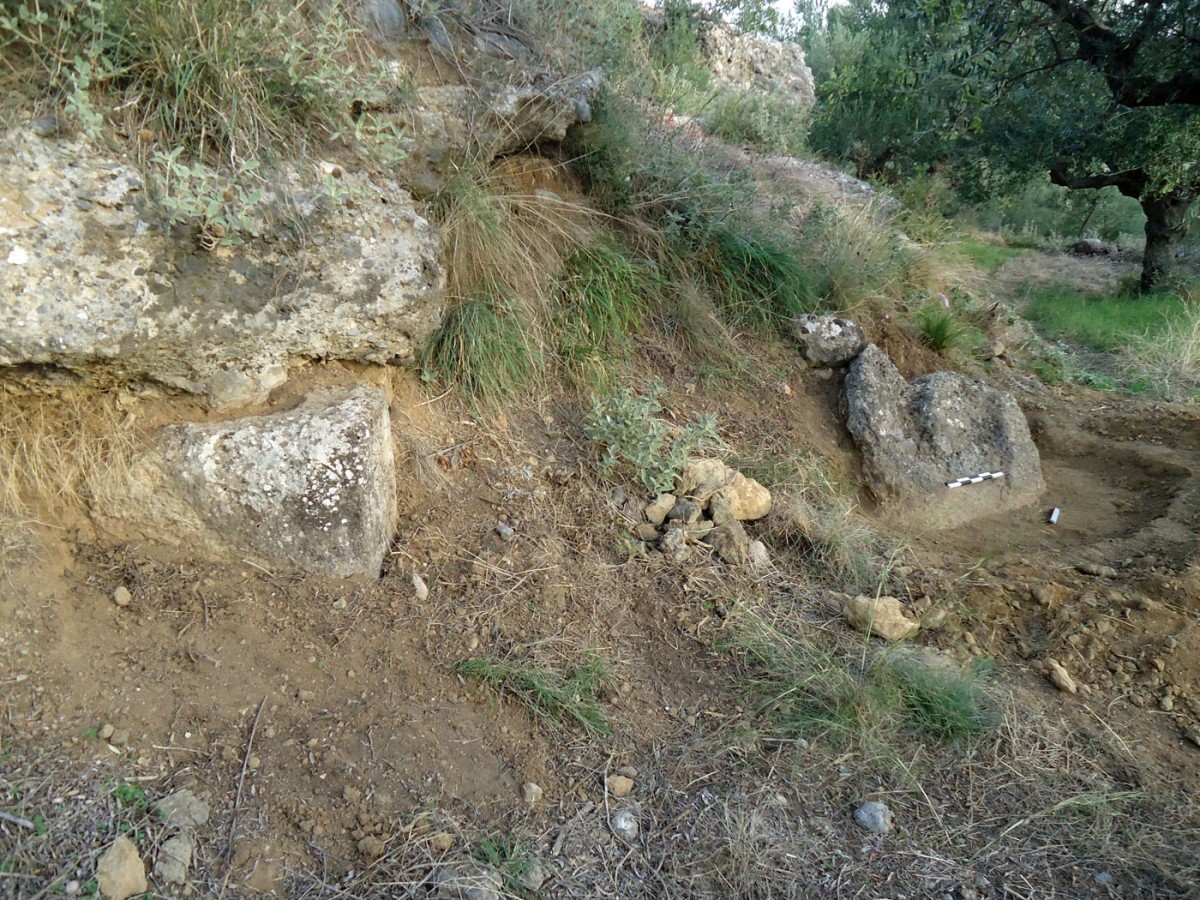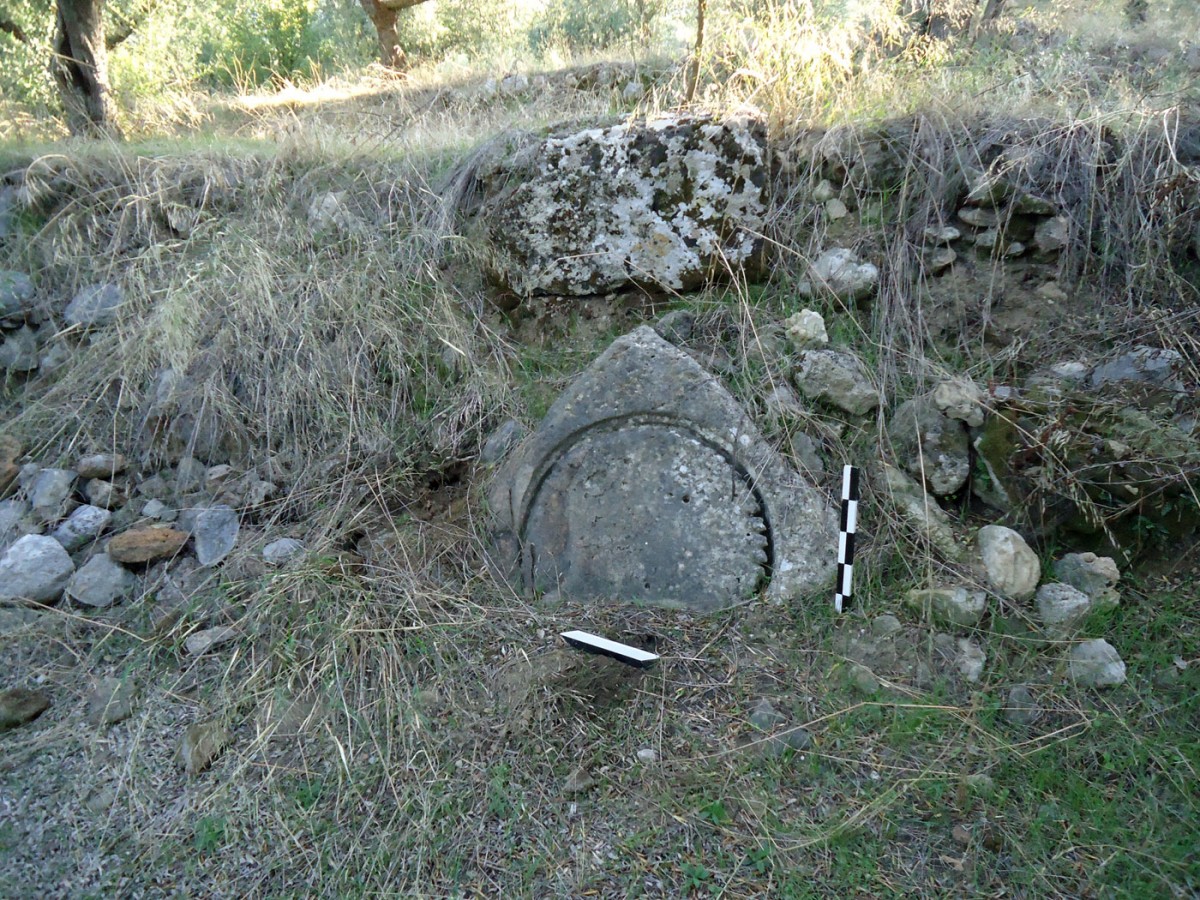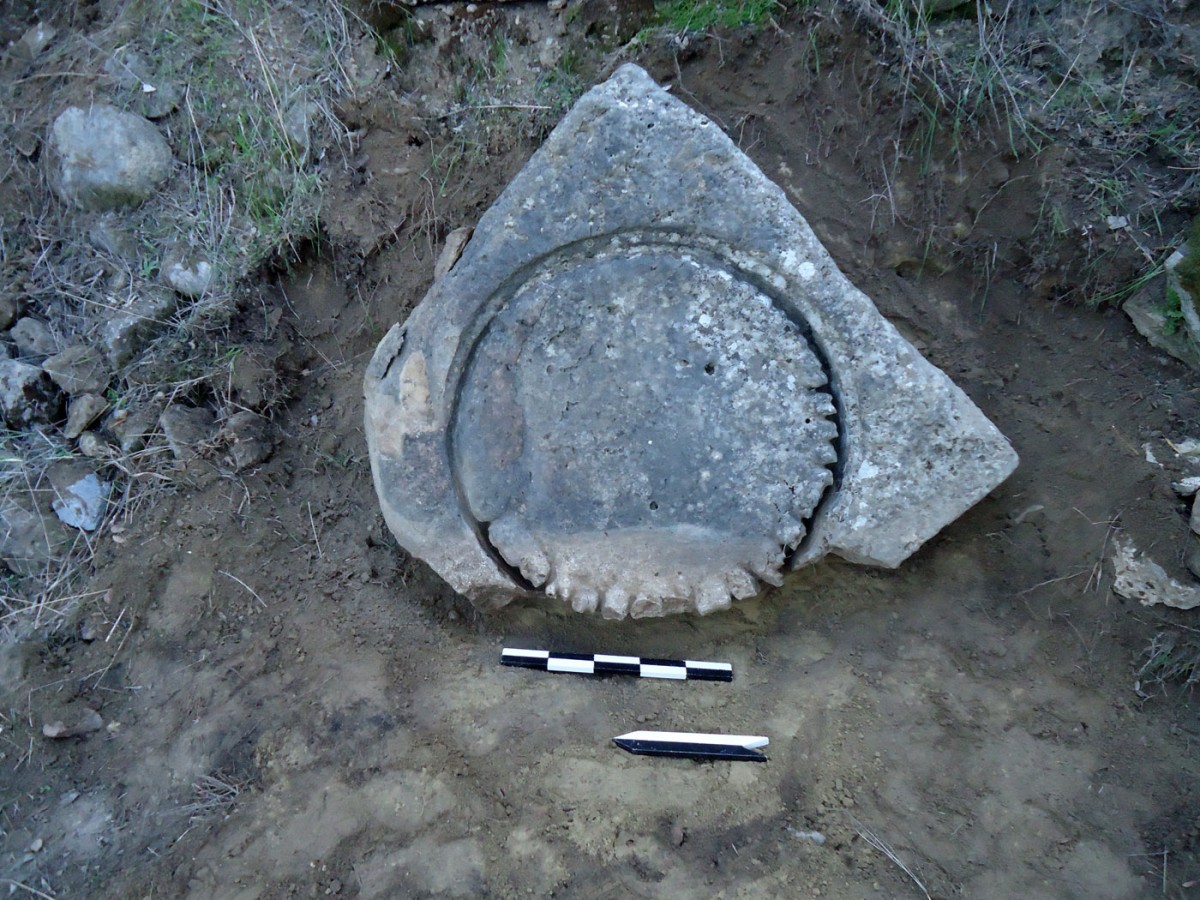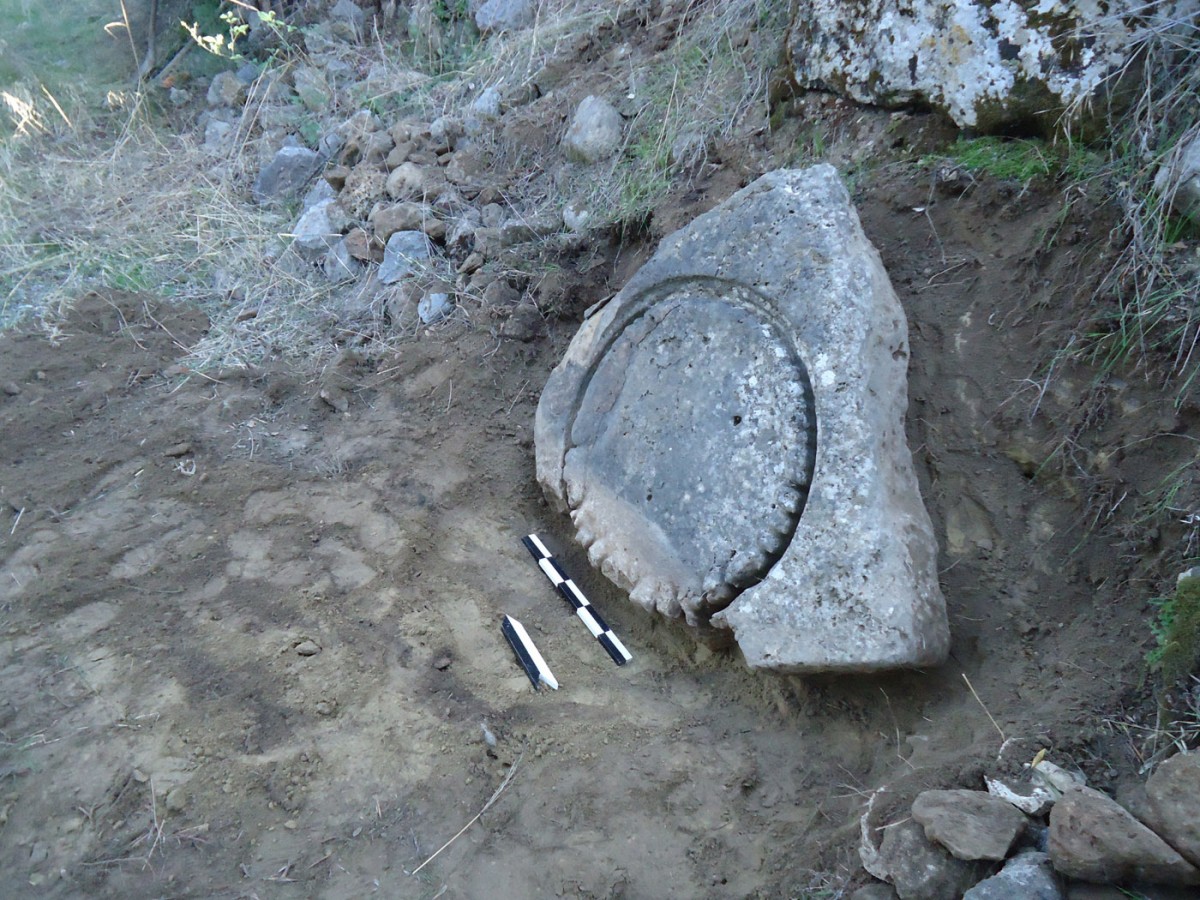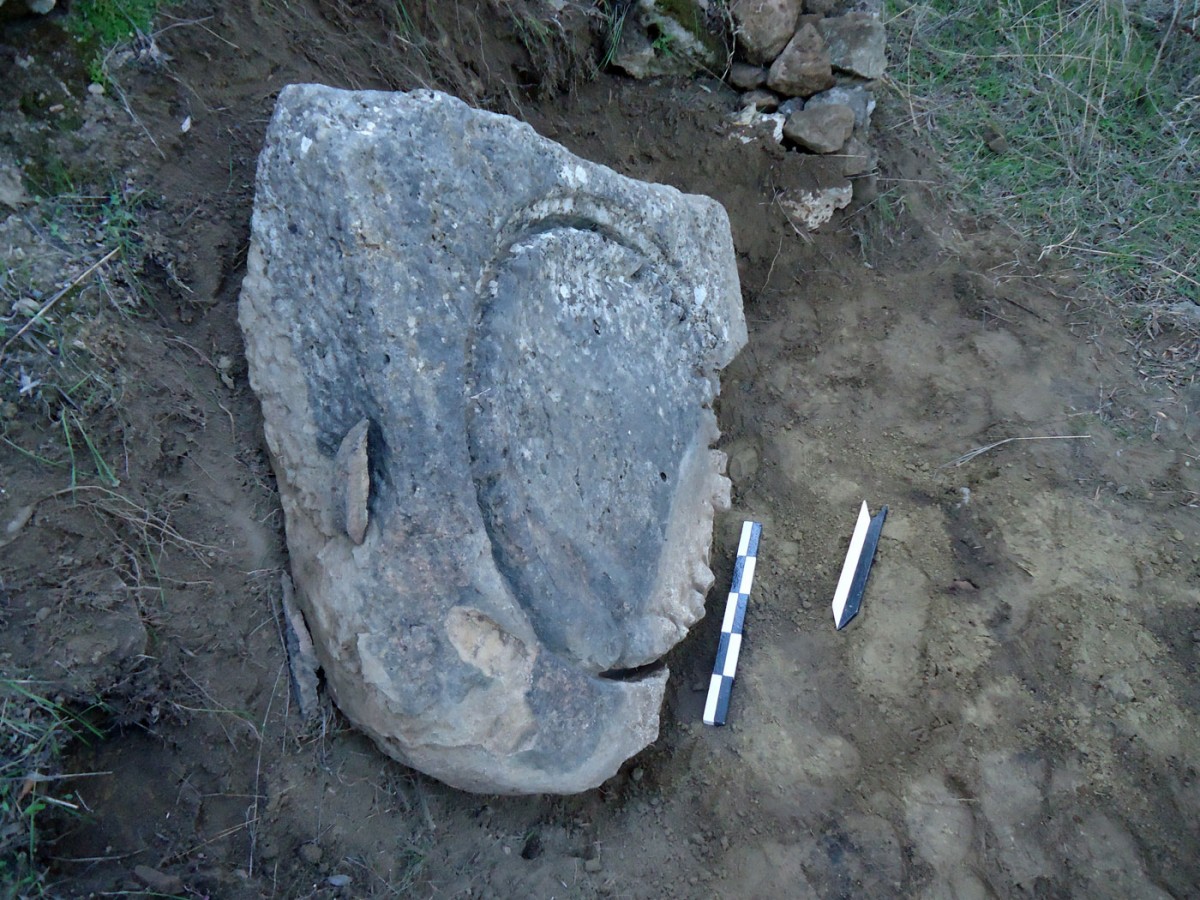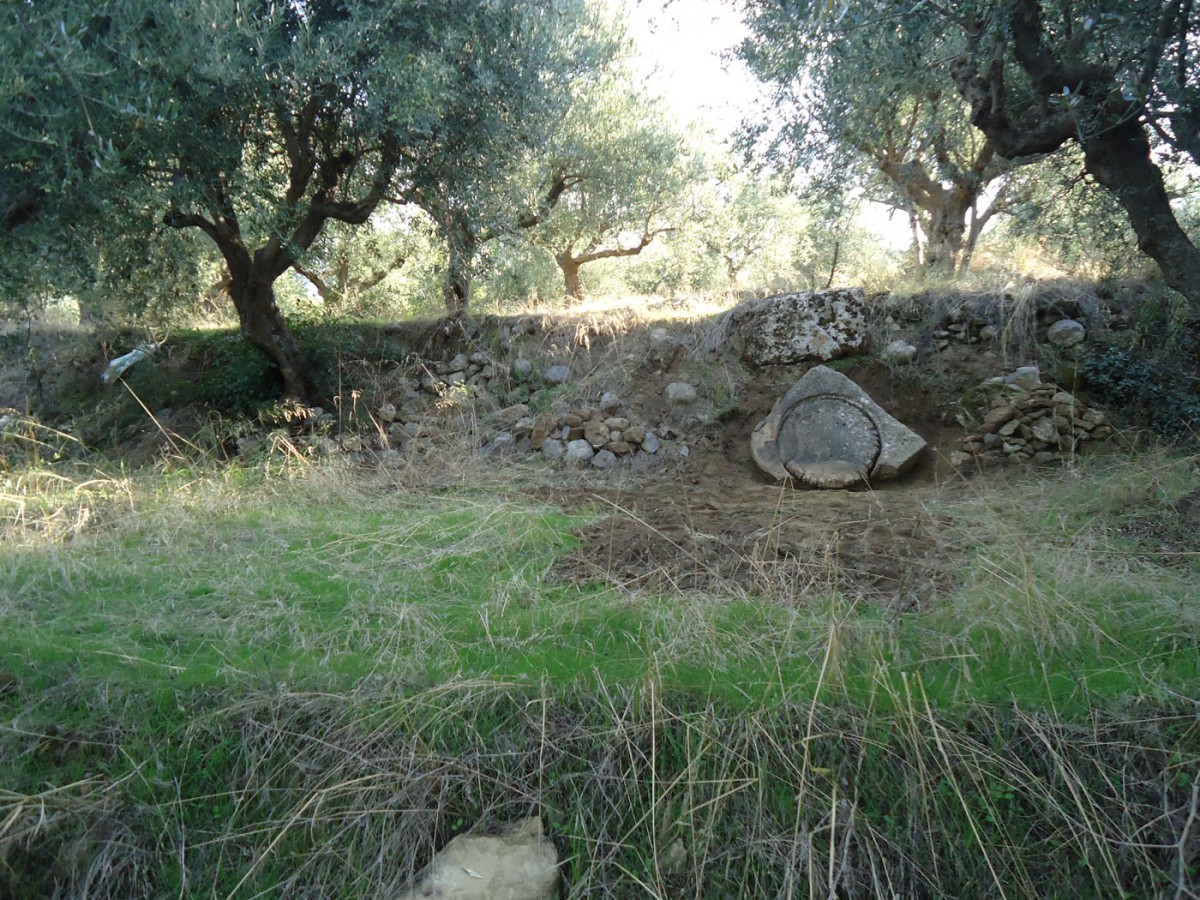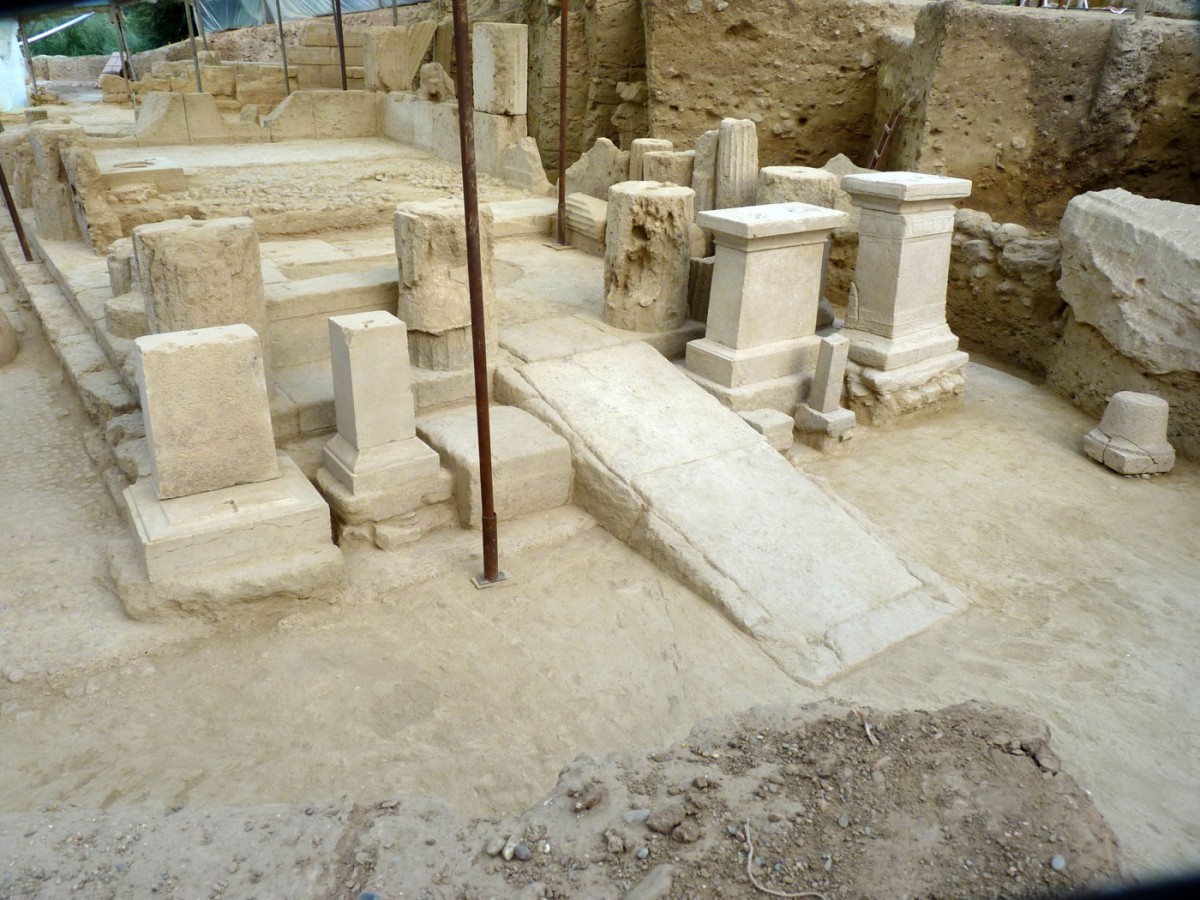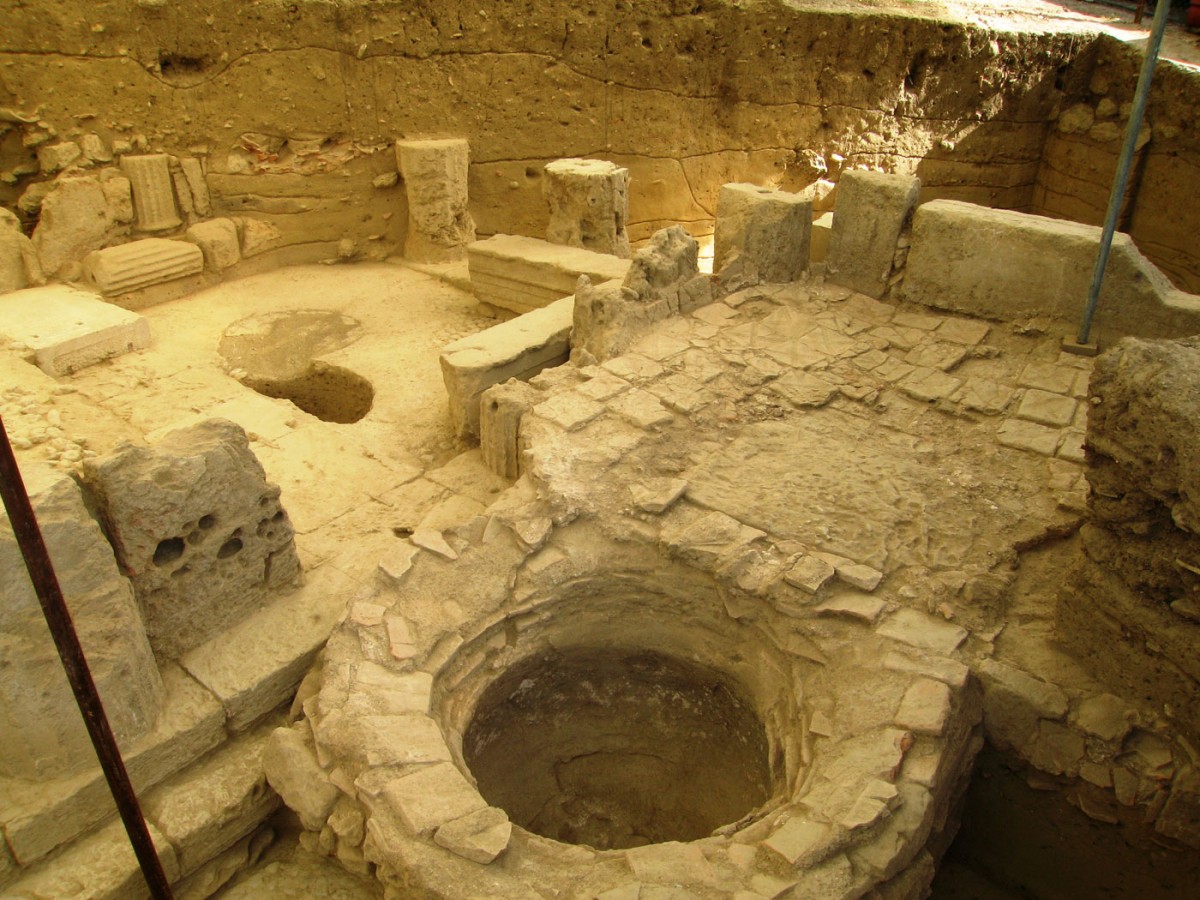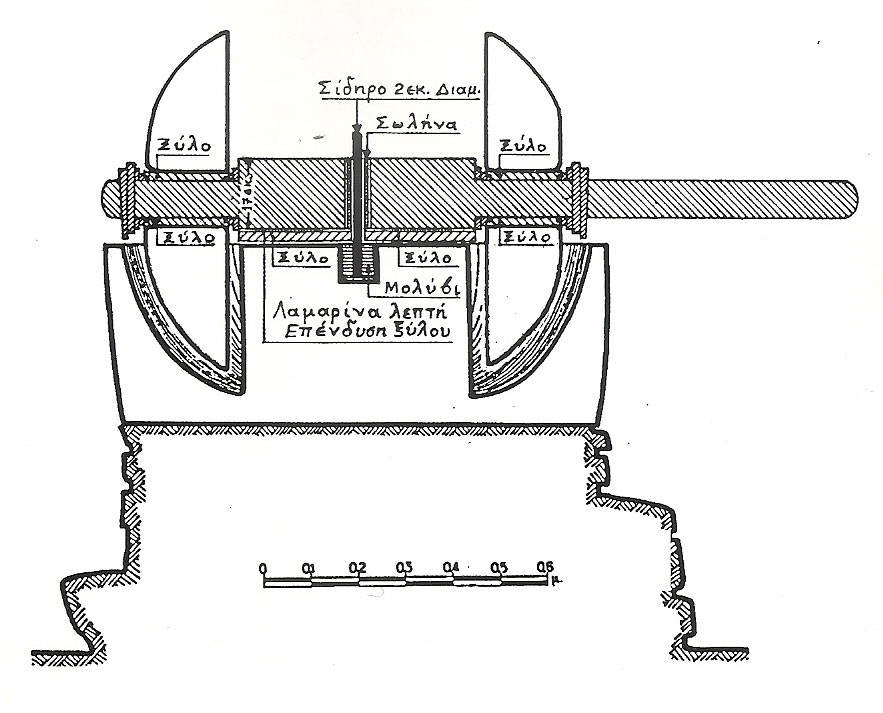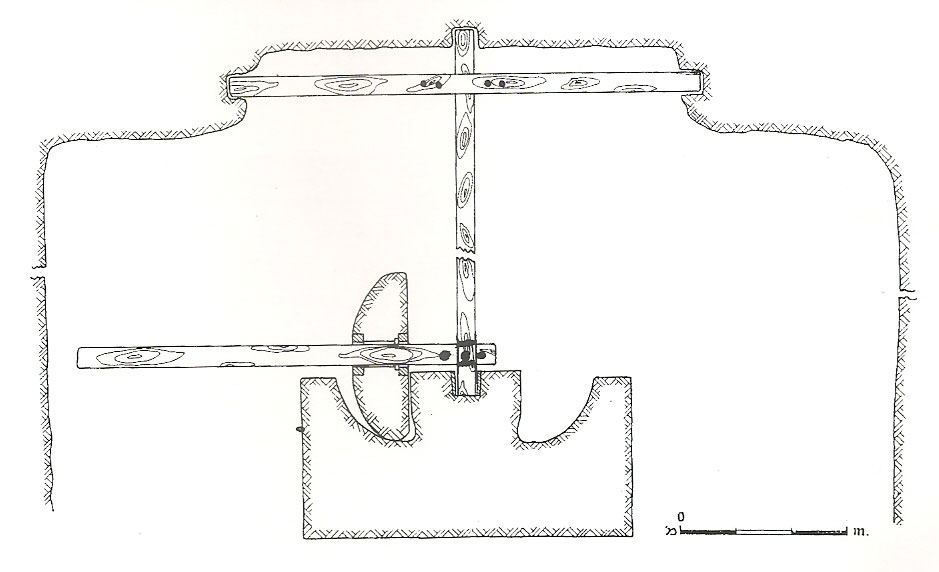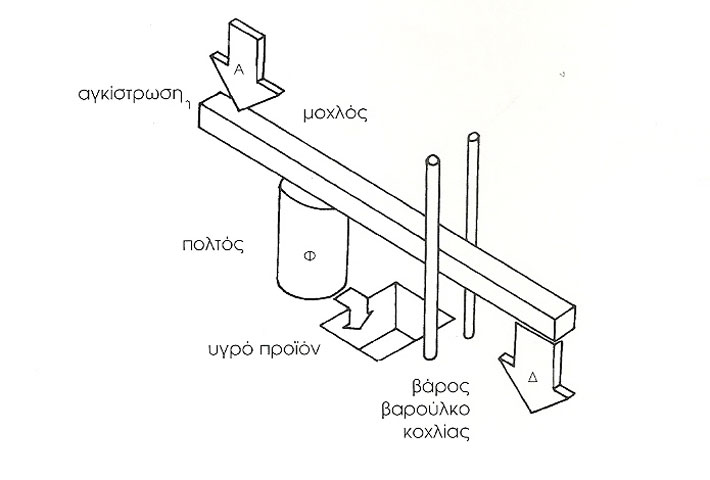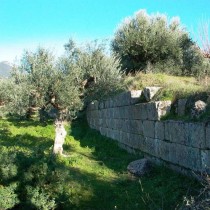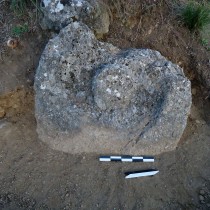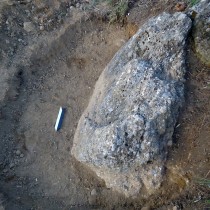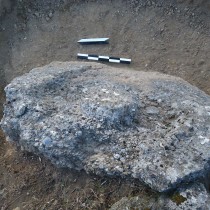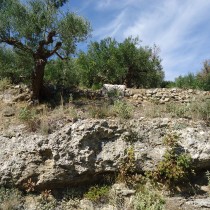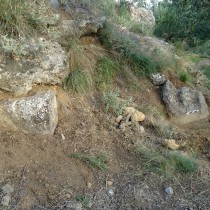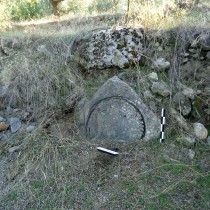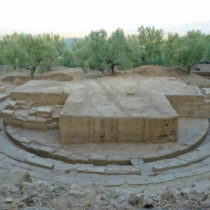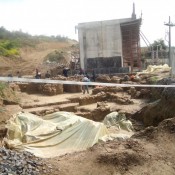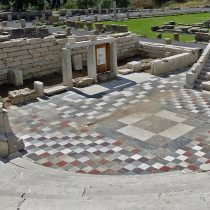While touring the region known as ‟Hellenika” in ancient Thouria, on the flat top of the hill at the site of the ancient city, sections of distinctive stone members originating from ancient olive presses (note 1) were located in privately owned olive groves.
Before describing these architectural members, the ancient process of producing olive oil will be presented, on which there is abundant, detailed Greek and foreign bibliography, while valuable information is to be drawn from the ancient authors Cato and Columella (note 2).
Stages of oil production in antiquity are the following: a) Cultivation of the olive tree and harvesting the olives. b) Crushing of olives to produce the pulp. c) Compression of pulp for production of the liquid which is collected while the olive stones are discarded and d) Separation of liquid into pure olive oil stored in jars or reservoirs and impure plant liquids unsuitable for consumption.
For centuries, all through antiquity, two techniques were used for the crushing of the olive (note 3): a) the trapetum (tropeion) and b) the mola olearia (olive mill).
The trapetum (note 4) consists of a large stone basin (mortarium) in the middle of which a small cylindrical column is attached (milarium). On top of the column is a carved rectangular tenon on which an iron pin (columella) can be adjusted. A horizontal wooden shaft, supported by its middle on the pin, bears on either end a lens shaped mill stone (orbes), flat on its inner side and curved on the outer (note 5).The two millstones are partially sunk in a stone basin, that is filled with olives. A double rotational movement of the millstones, done either by humans or animals, is achieved by using the protruding handle formed on one of the two edges of the horizontal shaft penetrating the millstones. Due to the gap between the millstones and the basin the olives are crushed but not their stones (note 6) (drawing 1).
The trapetum must have been introduced to Greece in Hellenistic times and continues to be used throughout the whole Byzantine era (note 7).
The type of olive mill known as mola olearia is dominant from the time of the Romans (1st c. BC to 1st c. AD) and develops over time, remaining in use up to and during the 20th century (note 8). It usually consists of one or sometimes two cylindrical millstones pierced by a horizontal shaft which is attached to an upright beam. The millstones revolve round the vertical beam on a flat surface where the olives are crushed. When the olive mill operates indoors the vertical beam is fixed to the ceiling by a permanent devise. When the oil mill works out doors, then the vertical shaft is replaced by a thick, tall pin adjusted to the central circular or square tenon growing out of a shallow stone basin. The pin pierces the horizontal wooden shaft on whose one end the mill stone is attached, while the other free protruding edge is used to rotate the olive mill by hand or using some animal (note 9) (drawing 2).
The crushing of the olive paste was done in the presses basically by following the use of weight as a method which evolved over time (note 10). The olive presses consist of a stone base which is square,circular or ellipsoid and surrounded by a circular groove (canalis rotunda) ending in an outflow channel with usually a protruding funnel. Cloth sacks with the olive paste are stacked on this base that is on a raised level. The liquid coming from the compression of the sacks is collected in vessels or reservoirs that are placed under the funnel. The simplest and oldest manner of compression was done with the use of stone weights hung from the end of a wooden lever, whose one edge was permanently fixed to a recess in the wall (note 11) (drawing 3). In later Hellenistic times a winch was used as a weight lifting device, while in the Roman era the screw is introduced on a stone base with distinctive tenons (γαλεάγρα) (note 12). To facilitate the extraction of oil, the oil pulp was moistened during compression with plenty of warm water. The oil was separated into eitherstone or clay containers, or reservoirs on whose bottom was a cavity for the sediment of plant fluids to settle, while the oil floated, due to gravity (note 13).
“Hellenika” in Thouria: The basin of the olive press
Inside the olive grove of Nikitas Krikkas, situated on the east side of the hill of ancient Thouria, a short distance south east of the surviving part of the citadel’s fortification wall (fig. 1), a large slab like rock is visible with one broad surface carved and well polished. The rock’s rear surface is rough, the boulder is vertically wedged in the hill side, hiding most of its lower part which is covered with soil. A day’s work was required to reveal the rock’s entire length. The slab like rock’s full length is 2.10m x 1.40m wide x 0.40m thick. On its upper end, visible from the start as it protruded from the soil, is a carved, shallow, round cavity with a diameter of 0.95-0.98m. In its centre there is a cylindrical knob, 0.10m high and with a diameter of 0.35m. The cavity surrounding the central knob is 0.30m wide. One part of the cavity’s circumference is missing, because of damage sustained by the visible upper end of the rock.
Even though it is shallow, the carved hollow resembles the basin of a olive mill of the mola olearia type, where the olives were crushed using a cylindrical mill stone rotating in the basin with the help of a horizontal wooden shaft. Because of the damaged central column, we do not know the way the vertical shaft was fixed or the pin on which the horizontal wooden rotation beam would be adjusted (note 14) (figs. 2, 3, 4).
It is, however, clear that the olive mill operated in the open air, since the natural conglomerate rock, which offered itself to this use being very hard and durable, had been appropriately carved (note 15). The vertical position the bulky carved rock was found in is problematic (note 16). While investigating the immediate environment and mainly the level formed above the vertically wedged boulder, a natural formation of the soil was observed with a layer of massive slab like conglomerate rocks, similar to it (fig. 5). It is therefore probable that the section of the carved rock – olive press, situated on the ‟brow” of the slope, got broken off from the network of other rocks on the flat surface above and slid down the hill side. Besides, the phenomenon of landslides from the hill top of the ancient city of Thouria down its east and west slopes, is a phenomenon that has been observed on a great scale in antiquity and continues at times to the present day (note 17).
The question therefore, is whether the landslide took place before the olive mill started to operate, in which case its construction was not completed, or if the rock was severed while the mill was already in use.
The period during which the rock fell also remains unknown.
By removing the loose, light brown soil covering the lower invisible part of the carved boulder, quite a number of black glazed shards from Hellenistic times were collected, as well as sections of well fired roof tiles that may have come from an ancient building located on the hill slope, a stone’s throw away from the carved rock. A section of wall is visible from this building, facing N-S, carefully constructed and consisting of a double row of rectangular stone blocks, built according to the isodomic masonry system (fig. 6).
The above facts are in agreement that the fall of the rock occurred either before the Hellenistic era or during the same time the adjacent building was constructed. In this case it could be assumed that the reason for this building’s abandonment in antiquity was the landslide. Without the necessary excavation survey, however, it is impossible to arrive at any safe chronological conclusions.
“Hellenikon Monastery”: A section of the compression base (olive press)
Inside the property of Ioannis Filiopoulos, situated a short distance south west of the Hellenikon monastery, a stone compression base was located on an elevated piece of ground.
The base was being used a second time round in a modern dry stone wall with a N-S direction, that sets the boundaries on the farm’s east side. It is vertically placed so that its upper surface can be seen on the wall’s facade (fig. 7).
The base is square, made of grayish limestone (note 18). The one side which is 1.12m long, is intact, with the other two partially surviving sides measuring 0.87 and 0.34 m respectively. The fourth side on which must have been the channel for the liquid’s outflow is entirely missing (fig. 8). Therefore we do not know if there was a funnel in the middle of the missing side, or if the oil produced from the compression of the olives was channeled towards the collection point, along a simple outflow canal. The base is 0.25m thick. Its round section surrounded by a groove 0.06m wide and 0.04-0.095m deep, has an inner diameter of 0.76m and an outer of 0.88m. On all the circumference of the round groove there are short but quite deep vertical incisions. The latter facilitate the oil to spread in the circular groove during the pressing of the olives which have been previously crushed (figs. 9-10).
It is evident that the olive press is not in its place, while there are no traces, on the surface at least, of an olive press having been installed in the vicinity. Nevertheless, because of its great weight, one should exclude its having been transported over a long distance for it to be used solely as a structural element in a modern dry stone wall (fig. 11). Therefore the search for the ancient olive press should not take place far from the fallen olive compression base. Surface survey in the olive press’ greater area, unearthed Hellenistic ceramics which however are spread across the whole site of the ancient city (note 19).
The Asklepeion of Ancient Thouria: “Panagitsa” Site
During excavations at the Asklepeion in Ancient Thouria (note 20) (fig. 12), at the ‟Panagitsa” site, fragments of surviving stone elements were occasionally found ,used a second time round as building material on later stone walls (note 21). Their poor state of preservation, however, does not allow them to be identified with certainty with any particular installation for olive processing. Besides, according to excavation data, it is known that at this spot there was a wine press of the Early Christian era (6th-7th c.) to which could be attributed the stone equipment originating from some workshop (fig. 13). Also found scattered around in the same place as the ancient temple were large ceramic jars, from the same period as the wine press, to be used for the storage of liquid or solid goods (note 22).
The absence, to date, of remains of ancient installations for olive processing in Messenia cannot be explained by scholars, particularly in a place that has been producing oil par excellence over time; at least from the Mycenaean era to the present day (note 23).
Data available to us on the processing of olives and olive presses in Messenia was almost non-existent. This was probably due to the lack of sufficient surface surveys on the extensive archaeological sites of the district, most of which remain unknown and have never been excavated.
The remains of ancient olive presses located in the ancient town of Thouria are the first reliable witnesses of olive production and olive processing in Messenia during antiquity.
Documentation remains to be done of excavation evidence given us by the site’s surface survey, in the hope of uncovering a completed olive press installation in ancient Thouria.
Xeni Arapogianni
Dr of Archaeology
Appendix: Olive presses from antiquity to the mid 20th century
From antiquity to the present day the stages in processing olives into olive oil have been the following: a) friction or crushing of the olives, b) squeezing out of the olive pulp and c) separation of the oil from its other ingredients. During the first stage, the crushing-breaking of the olives is carried out so as to subsequently extract the olive oil by squeezing it out (note 24).
The beginnings of olive cultivation in Greece can be placed in the Early Bronze Age (3rd millennium BC), while its intense, systematic cultivation occurs in the Mycenaean era (1680-1100 BC) (note 25).
Initially, the crushing of the olives is done by hand in big stone basins, using a round stone to exert pressure.The olive pulp is extracted with the use of presses. These are either circular or rectangular stone compression bases. A lever is used to put pressure on the olive pulp, i.e. a wooden beam fixed to arecess in the wall/hollow of a rock or some other structure, on whose free end some type of force is used, either muscular or with the use of stone weights (note 26).
Between the Late Bronze Age and the Classical Period, no substantial changes are to be found in the production of oil. Gradually there is an increase in the weight of the beams in the presses and the stone bases acquire a circular groove ending in an efflux (note 27).
One of the most important innovations is to be seen during the Hellenistic era: this is the rotating mill, known as the trapetum, used to crush the olives. This type continues to be used right through the Byzantine period. During Roman times, another type is also created, namely the olive mill or mola olearia. This continues to exist with various modifications till the mid 20th century. For compression, olive presses used methods similar to ones in prehistoric installations. In Hellenistic times, the winch was used as a weight lifting device, while in Roman times the screw was introduced, mounted on a stone base with distinctive sockets (γαλεάγρα) and a circular groove for the liquid to flow off (note 28).
In the mid Byzantine period of the 10th to 12th centuries AD, the cultivation of olives became more intense in the Peloponnese, more so in regions of Messenia during the 13th century (note 29). Regarding the technology of producing olive oil , the two known types of olive mill continued to exist, i.e. the trapetum and the mola olearia. The olive mill consists of a stable monolithic or built base, powered by humans or animals for it to move. On the bottom of the basin is an opening from which the olive pulp emerges. The prevailing press of the period is the screw mechanism. It consists of a winding, vertical, wooden cylindrical beam, placed upright on a stone mount (γαλεάγρα), which rotates on the free end of the compression lever. On the screw’s lower part is a hollow in which a small wooden beam is placed, used as a crowbar (note 30).
Olive cultivation expands during both Venetian and subsequently Turkish rule, and there is an increase of olive oil production in the Peloponnese, which improves oil processing installations (note 31). The mechanical parts of the olive press include the mill, consisting of one to three millstones placed in a flat basin. Power for crushing olives is still supplied by humans or animals. The presses are wooden, of the wooden screw type.
In the 19th century, the number of olive trees increase in Greece as well as the production of olive oil (note 32). This however does not apply to the means of its production where human or animal power continues as a method and likewise the use of various types of mills and presses.
An early method of manually powered olive mill that survived in the Peloponnese was that of the cylinder or Hi-Hoop (χάι-χουπ) (note 33). This was a cylindrical stone (60-70 cms high with a base diameter of 30-40 cm) and a convex or flat surface where olives were crushed with recurring movements (note 34). Compression of the olive pulp was done in wooden, manually powered presses with a tub or with the feet (note 35).
The most common method used in the Peloponnese, dating from the mid 19th to the early 20th century, were animal powered mills divided into three types depending on the size and number of millstones (note 36).
The animal powered mills were long, one room stone buildings with a pitched roof. They usually had storage space and a well or cistern. Indoors, apart from the basic facilities, there were stone compartments for putting the olives and feeding the animals, as well as space for storing olive oil in jars. On one side of the building, a circular stone threshing floor was built considerably above ground level, for the grinding of the olives. The mill stones or upper stones (πανωλίθια) were placed on the threshing floor’s top part. These were joined together by an iron shaft which went through another vertical wooden one. The vertical shaft rested on the centre of the lower stone (κατωλίθι) on two thick pieces of wood fixed to the roof of the olive press. One more wooden shaft was connected with the vertical shaft, tilted slightly towards the ground, to which the animal was tied.The mill stones were made of granite, with a diameter of 1-1.20m and a width of 0.30m.
The ground olives were collected in a wooden tub and then the pulp was put into haircloth sacks (τσαντίλες). The sacks were placed with great care in the press, for the next stage of compression. At the end of the 19th century the wooden presses (note 37) were replaced by metallic ones. Theseweremadeinmetal workshops of Attica and Piraeus and there were various types (note 38).
Water mills were rare in Messenia. The use of water power for the operation of olive presses begins in the Post Byzantine period and becomes wide spread in the 19th century. There were two categories of water powered olive presses: Mills with either a horizontal or vertical wheel. In the Desylla region of Messenia, a well preserved water powered mill survives with a horizontal wheel (note 39).
In the late 19th and early 20th century engine powered olive presses, the so called factories, made their appearance. These included steam powered, machine powered and hydraulic mills. During this period, a great change occurred in reducing the time of processing and crushing the olives and extracting the oil. The screw press was changed to a hydraulic one and the animal powered mill was redesigned and reinforced so as to accommodate both greater loads and the straps for engine power. Basic changes were made to the threshing floor and the mill stones, the former being made completely of iron and the latter of a harder stone to cope with the pressures. Steampoweredolivepressesweredominanttill 1925, when they were replaced by petrol engines. After 1947,steam engines started to be mass produced in the place of petrol engines (note 40). After 1960, most engine powered olive presses in the Peloponnese were changed into ones powered by electricity.
Yiannis Kakouros
Archaeologist
